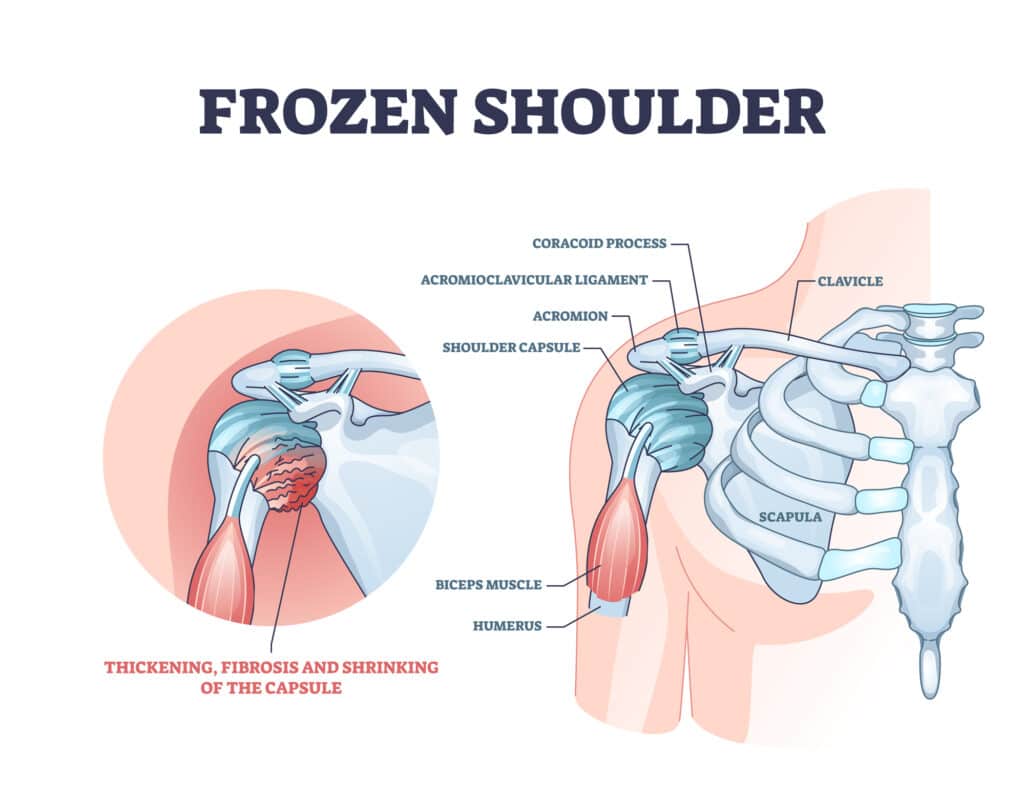 Does your shoulder joint feel stiff and immovable like it’s “frozen”?
Does your shoulder joint feel stiff and immovable like it’s “frozen”?
Are the activities that were once effortless for you, such as reaching up to a high cupboard or lifting weights above your head at the gym, now almost impossible due to limited range of motion?
If so, you may be suffering from a frozen shoulder—a condition that causes pain and stiffness around the shoulder joint. In this article, we cover what frozen shoulder is, why it occurs, risk factors associated with it, treatments for it, and prevention tips.
So, if you think you have —or might be developing—frozen shoulder syndrome, you’ve come to the right place.
More Blogs From Osteoworks
Neck Mobility Exercises for a Tight Neck
Thoracic Mobility is so Easy to Improve
Prevent lower-back injury with this simple routine 2021
What Is Frozen Shoulder, And What Are The Symptoms?
This condition, which is also known as “adhesive capsulitis”, can be excruciating and really frustrating. We’re not really into labels – for us as osteopaths, your body is either well aligned, moving and functioning well, or it isn’t, and we work to fix it and restore optimal health.
The name/label for the condition is less important. But essentially, a frozen shoulder occurs when the capsule of ligaments, tendons and connective tissue surrounding your shoulder joint becomes thickened and tight, causing decreased mobility – and the shoulder becomes stiff and painful.
It usually affects people between 40 and 60 and can last many months, even up to two years.
A frozen shoulder can be caused by a variety of things such as injury, surgery, or even just prolonged periods of inactivity. The tell-tale symptoms of this condition include pain and stiffness, reduced range of motion, and difficulty reaching behind your back or overhead.
It can also cause a great deal of discomfort and physical disability/limitation, and daily tasks like getting dressed become virtually impossible.
However, diagnosing a frozen shoulder can be tricky because it often presents with symptoms that can overlap with other conditions. But with a careful examination by a trained osteopath, we can successfully rule out other conditions and causes and recommend a treatment plan to help you find relief and regain your full range of motion and functionality.
What Are The Benefits of Osteopathic Treatment For Frozen Shoulder
Having a frozen shoulder can be a real pain, both literally and figuratively. Limited range of motion, constant discomfort, and difficulty completing everyday tasks can make life pretty miserable. But that’s where Osteopathy may be able to help.
Osteopathy is a manual therapy that can often help with Frozen Shoulder Syndrome. We are able to reduce pain and increase the range of motion by using gentle techniques to mobilize your shoulder joint and realign your posture.
Osteopathy also addresses any tension or strain in the surrounding muscles and tissues, which can contribute to the condition. So, if you’re struggling with Frozen Shoulder Syndrome, it could be a great treatment option for you.
But what exactly is Osteopathy?
Osteopathy is a natural, drug-free therapy that works with your body’s innate systems to relieve pain and stiffness while promoting fluidity and mobility. It addresses the physical and energetic aspects of illnesses and the relationship between the body’s structure and function.
It is predominantly a hands-on therapy that gently manipulates the bones, muscles, and other tissues. But we also look at your lifestyle, habits, diet, emotions, and environment to work out what might be causing your symptoms.
Simply put, we focus on treating the root cause of your shoulder issues rather than just alleviating symptoms. Then we help to restore your body’s natural balance.
Osteopathy can improve joint function and promote healing by targeting the body as a whole. But it doesn’t just reduce pain; many patients also report increased energy levels and an improved sense of wellbeing as well.
Using targeted manipulation and gentle stretching exercises, we work with you to alleviate pain and increase mobility in the affected shoulder joint.
Not only does this help to restore your overall mobility and range of motion, but it can also improve your quality of life by enabling you to get back to playing sports or doing yoga and all the other things you love without the constant hindrance of frozen shoulder pain and stiffness.
Essentially, Osteopathy is a form of physical therapy that focuses on the overall health and postural alignment of your musculoskeletal system.
During the treatment process for a frozen shoulder, we use hands-on techniques to help ease the tension and stiffness in your shoulder joint. This may include gentle stretching exercises, massage, and other therapeutic interventions. Over time, we can increase the range of motion in your shoulder and reduce your pain levels.
One of the core techniques we use is soft tissue massage, designed to release tension and improve blood and lymph flow throughout your entire body.
Another important technique is joint mobilization, which involves gently moving the joints through their natural range of motion to improve flexibility and reduce pain. Finally, articulation involves realigning the joints through precise movements to restore proper function and relieve discomfort.
By combining these techniques, we can help you achieve optimal health and wellness by addressing a wide range of conditions and symptoms.
We believe that the body is a unit, and all its parts work together to keep it healthy. We focus on your musculoskeletal system, examining the joints, muscles, and bones and your postural alignment.
This philosophy of treating the whole person, not just the disease, is what makes it such an effective therapy. Whether you are experiencing frozen shoulder, chronic back pain, headaches, or joint pain, we can help relieve your pain and stiffness and therefore improve your quality of life.
Osteopathy can be a great way to manage the symptoms of a frozen shoulder. Still, there are some simple exercises that you can do at home to improve the health of your shoulder joint. One of these exercises is called the pendulum exercise, where you stand and swing your affected arm in small circles.
Another great exercise is the towel stretch, where you hold onto a towel with both hands and use it to stretch the affected arm gently. These exercises may seem simple, but they can make a big difference in the speed and effectiveness of your recovery journey in combination with regular Osteopathy.
How To Prevent Frozen Shoulder Or Worsening Symptoms
After osteopathic treatment for a frozen shoulder, there are some things you can do at home to prevent the condition from returning. You can also follow this guide to prevent worsening pain if you’re still in the healing stage of the condition.
- Stretching Exercises: A frozen shoulder can cause great discomfort, limit range of motion, and make everyday movements challenging. Fortunately, stretching exercises can offer some relief from those symptoms.
Gentle movements that stretch the shoulder joint and surrounding muscles can help reduce pain and increase your flexibility. It’s essential to start with simple stretches, gradually increasing intensity over time. Stretches should be held for at least 30 seconds, repeated several times daily, and done with proper form to avoid injury. With consistent effort and dedication, stretching exercises can be an effective tool for managing frozen shoulder pain. - Proper Posture: Maintaining good posture can minimize a frozen shoulder’s impact on your daily life. Good posture helps to align your shoulder joint correctly, reducing the strain on the tendons and muscles that are affected by a frozen shoulder. When you sit or stand up and pay attention to your posture, you allow your body to move naturally without putting unnecessary tension on your shoulders. Also, maintaining good posture helps improve your health and wellbeing by reducing the risk of other musculoskeletal issues and keeping your body moving well.
- Modify Your Environment: Your environment significantly impacts your daily life, especially when it comes to joint health. If you experience joint pain or discomfort, modifying your environment can help alleviate unnecessary stress in those affected areas.
Simple modifications such as adding cushioning to hard floors, using a knee pad while gardening, or using ergonomic tools and furniture can make a big difference. Additionally, organizing your space to reduce clutter and avoid excessive bending or reaching can help reduce joint stress. By taking the time to make these changes, you can support your joint health and reduce your risk of frozen shoulder returning. - Using Heat/Ice Therapy: Living with joint pain can be really uncomfortable and exhausting. However, heat/ice therapy can comfort and soothe the area, relieve the discomfort, and help improve your range of motion.
Applying heat to affected joints can improve blood circulation, reduce stiffness, and ease pain. On the other hand, applying ice to the joints can reduce inflammation and pain, especially after physical activity. You can also use heat and ice therapy alternately to provide more significant pain relief, reduce muscle spasms, and improve joint flexibility. It certainly won’t fully fix the issue, but it can make it more manageable.





